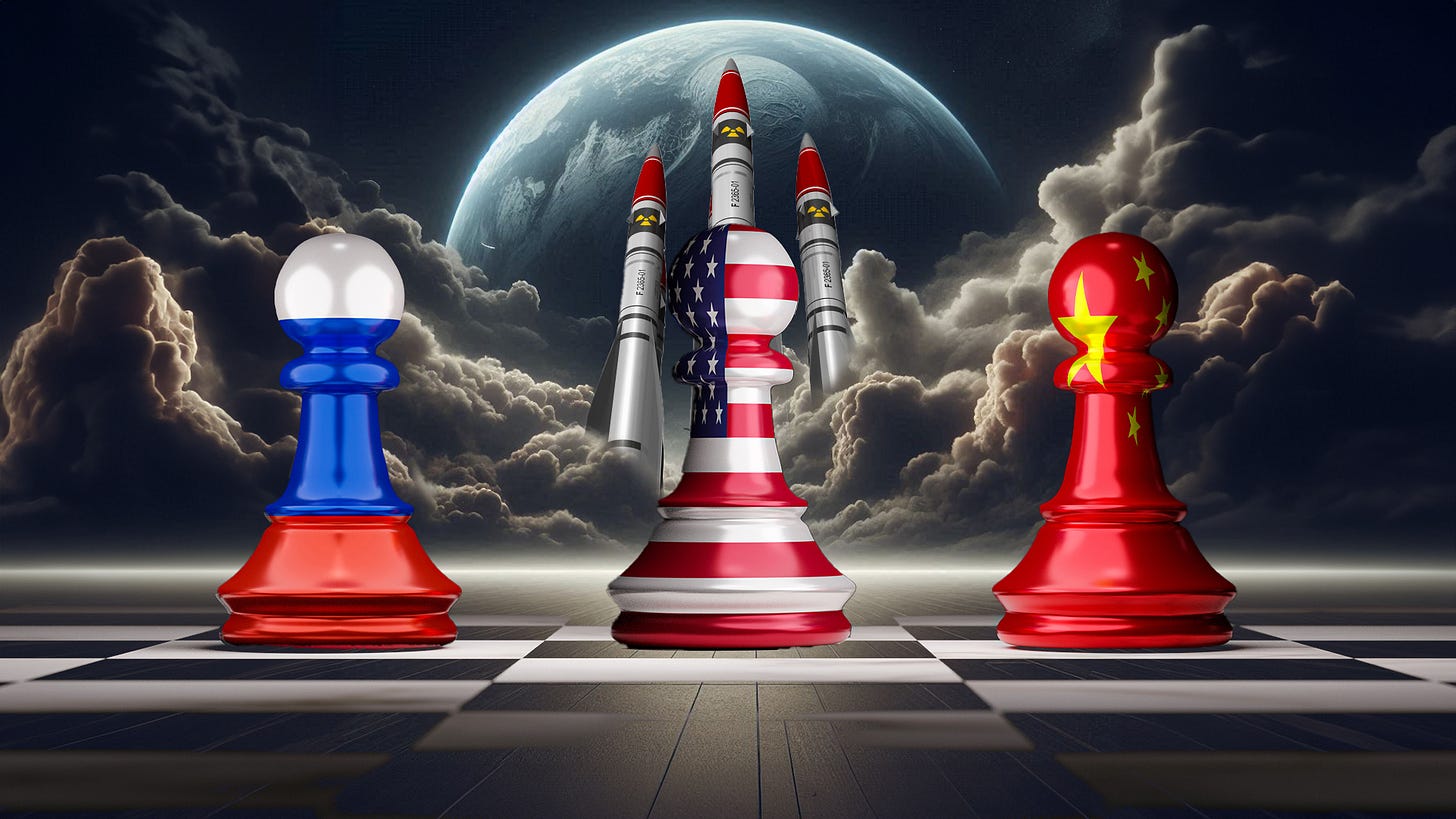The New Hot Wars
By Jeremy Brecher, Senior Strategic Advisor, LNS Co-Founder
Listen to the audio version >>
“Polycrisis” is a word being used to describe the current confluence of military, geopolitical, economic, political, climate, and other crises. This series of commentaries on “The Polycrisis and the Global Green New Deal,” probes the dynamics of the polycrisis and what alternatives there might be to its race to destruction. This commentary, the third in the series, examines the stunning expansion of armed conflict in the polycrisis era.
The most blatant marker of the polycrisis is the burgeoning of war and preparation for war.
At the end of 2023, the International Institute for Strategic Studies in London in its annual Armed Conflict Survey documented 183 armed conflicts around the world in 2023, the highest number in three decades. Fatalities increased by 14% and violent events by 28% compared to the previous year. The numbers of refugees displaced by war are stunning: more than six million refugees in Syria, five million in Afghanistan, and a million in Myanmar have been displaced by war.
The Survey describes a world “dominated by increasingly intractable conflicts and armed violence amid a proliferation of actors, complex and overlapping motives, global influences and accelerating climate change.” In fact, it portrays “intractability” as the “defining feature of the contemporary global conflict landscape.”[1]
The Uppsala conflict data program reaches similar conclusions.[2] The past two years have seen more violent conflict than at any time since the end of World War II. As summarized in the end-of-2023 review by Phenomenal World, a leading source for analysis of the polycrisis:
Conflicts have broken out in many continents. In Africa, there have been over half a dozen coups, with combat fighting in the Congo and Sudan, and now a teetering cease-fire in Ethiopia. In the Middle East, Israel’s assault on Gaza threatens to expand into a regional war. In Europe, Russia’s brutal war of attrition in Ukraine has strikingly altered the political scene.[3]
The IISS emphasizes “the current complexity of contemporary wars, which often feature a large number of diverse non-state armed groups as well as external interference.” These groups are showing an “unprecedented degree of fragmentation, with a myriad of small-scale groups competing for control and influence in Sub-Saharan Africa, Latin America and the Middle East, among others.”
This, coupled with the diminished leverage of traditional resolution actors and processes, makes progress on their settlement a daunting task, contributing to their protractedness and resulting in little prospect for durable peace. The average duration of conflicts has increased over the last three decades amid an accelerated internationalization of internal wars.
As Adam Tooze observes, the fastest growing category of conflicts is neither inter- nor intra-state wars, but “internationalized intrastate conflicts.” They are largely fueled by “the new rivalry between the US, Russia, China and regional players like the Emirates and Saudi Arabia.”[4]
The respected International Crisis Group recently warned that “peacemaking” is “in crisis.”
Worldwide, diplomatic efforts to end fighting are failing. More leaders are pursuing their ends militarily. More believe they can get away with it. In Sudan, Myanmar, Nagorno-Karabakh, Tigray, Syria and potentially Taiwan, the story was the same, the ICG said. “Around the globe, more people are dying in fighting, being forced from their homes, or in need of aid than in decades.[5]
War and preparation for war are absorbing growing amounts of the world’s wealth. Total military spending by nations reached a record high of $2.443 trillion in 2023, according to an April, 2024 report by the Stockholm International Peace Research Institute (SIPRI). Worldwide, military spending grew by 6.8% in real terms over 2022, the steepest rise since 2009. The US spent $916 billion; China spent an estimated $296 billion; Russia spent an estimated $109 billion. Every region saw an increase, but Europe, Asia and Oceania, and the Middle East saw the greatest growth. According to the report’s senior author, Nan Tian, “The unprecedented rise in military spending is a direct response to the global deterioration in peace and security. States are prioritizing military strength but they risk an action-reaction spiral in the increasingly volatile geopolitical and security landscape.”[6]
War preparation is vividly illustrated by the escalating nuclear arms race. As the statement on the 2024 “Doomsday Clock” recounts,
February 2023, Russian President Vladimir Putin announced his decision to “suspend” the New Strategic Arms Reduction Treaty (New START). In March, he announced the deployment of tactical nuclear weapons in Belarus. In June, Sergei Karaganov, an advisor to Putin, urged Moscow to consider launching limited nuclear strikes on Western Europe as a way to bring the war in Ukraine to a favorable conclusion. In October, Russia’s Duma voted to withdraw Moscow’s ratification of the Comprehensive Nuclear Test Ban Treaty, as the US Senate continued to refuse even to debate ratification.[7]
Shortly thereafter, Russia’s military conducted a drill with a simulated nuclear strike. Russia’s minister of defense, Sergei Shoigu, said the purpose of the drill was to practice “dealing a massive nuclear strike with strategic offensive forces in response to a nuclear strike by the enemy.”[8]
Under the 2010 New START accord, which expires in 2026, both the United States and Russia have deployed 1,550 nuclear warheads on strategic or long-range delivery vehicles. According to the Washington Post, China, which for many years kept a nuclear arsenal in the low hundreds of warheads, “now appears to be heading toward at least 1,000 by the end of this decade,” and is “building a land-sea-air triad of delivery vehicles similar to that of Russia and the United States.” The Post editorial board warned, “Without arms control treaties, verification and crisis management channels, the United States might find itself in a dangerous three-way nuclear arms race.” Indeed, with the plans of all three great powers for nuclear “modernization,” such an arms race seems to be well under way.[9]
The new nuclear arms race has been made possible by a tit-for-tat demolition of the architecture of strategic arms control. In 2002 the US withdrew from the Anti-Ballistic Missile treaty; in 2019 from the Intermediate Range Nuclear Forces treaty; and in 2020 from the Open Skies treaty. In 2023 Russia withdrew from both the Conventional Armed Forces in Europe treaty and suspended participation in the New START treaty.
According to a study released in June 2024, over the past five years nuclear weapons spending has grown by an estimated 34%. For the US it was 45%. All nine of the world’s nuclear armed nations are increasing their nuclear budgets. Global spending increased by 13% during 2023. On current trends, nuclear weapons spending will surpass $100 billion in 2024.[10]
After the Cuban Missile Crisis of 1962, the United States and the Soviet Union both recognized how close they had come to a nuclear holocaust that would have obliterated both of them. This learning drove a process of détente and arms limitation, which helped generate the first ban on nuclear testing and a series of subsequent agreements limiting nuclear-armed missiles and other weapons of mass destruction. The limits placed on the nuclear arms race represented a shared recognition of the self-defeating folly of the quest for nuclear superiority. The renewed nuclear arms race represents a loss of that social learning – a loss of learning that is one of the hallmarks of the Polycrisis.
[1] Irene Mia, “The Armed Conflict Survey 2023,” International Institute for Strategic Studies (IISS),Routledge, 2023. https://www.iiss.org/en/publications/armed-conflict-survey/2023/editors-introduction/
[2] “Uppsala Conflict Data Program,” Uppsala University. Accessed June 14, 2024.
https://ucdp.uu.se
.
[3] Tim Sahay. “A Year in Crises,” Phenomenal World, December 21, 2023. https://www.phenomenalworld.org/analysis/a-year-in-crises/
[4] Adam Tooze. “Chartbook 258 War, peace and the return of history in 2023,” Chartbook, January 01, 2024.
.
[5] Simon Tisdall. “From Gaza to Ukraine, brute force threatens to triumph in 2024,” The Guardian, January 6, 2024. https://www.theguardian.com/commentisfree/2024/jan/06/from-gaza-to-ukraine-brute-force-threatens-to-triumph-in-2024.
[6] Nan Tian, Diego Lopes da Silva, Xiao Liang and Lorenzo Scarazzato. “Trends in World Military Expenditure, 2023,” SIPRI, April 2024. https://www.sipri.org/sites/default/files/2024-04/2404_fs_milex_2023.pdf. See also, Jim Lobe. “Who needs butter when you got guns? World arms spending reaches $2.5 trillion,” Responsible Statecraft, April 23, 2024. https://responsiblestatecraft.org/global-military-spending/.
[7] John Mecklin. “A moment of historic danger:
It is still 90 seconds to midnight,” Bulletin of the Atomic Scientists, January 23, 2024. https://thebulletin.org/doomsday-clock/current-time/.
[8] “Russia simulates nuclear strike after opting out of treaty.” theguardian.com, October 25, 2023. https://www.theguardian.com/world/2023/oct/25/russia-simulates-nuclear-strike-after-opting-out-of-treaty.
[9] “The nuclear arms race grows from two to three major competing powers,” washingtonpost.com, November 11, 2022. https://www.washingtonpost.com/opinions/2022/11/11/nuclear-posture-review-three-powers/.
[10] Dan Sabbagh, “Global spending on nuclear weapons up 13% in record rise,” The Guardian, June 17, 2024. https://www.theguardian.com/world/article/2024/jun/17/global-spending-on-nuclear-weapons-up-13-in-record-rise





